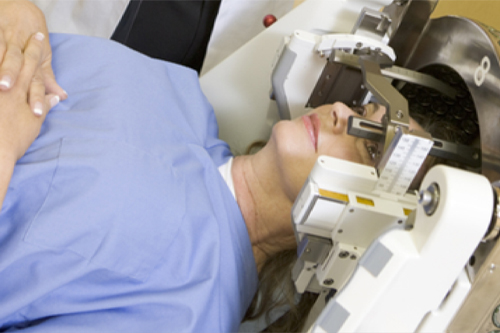
Gamma Knife surgery
Gamma Knife surgery In Nagpur, as the name would seem to suggest, does not involve a knife at all. This advance form of radiation therapy uses a device known as the Gamma Knife® to deliver focuse.Thus, precise doses of radiation to the brain.
This technique effectively helps reduce small-sized tumors of the brain, relieving abnormal blood vessel conditions. Furthermore, it is used in treating nerves that cause pains and seizures. It is further used in the management of some brain disorders like Parkinson’s disease.
That’s the “gamma knife,” an extraordinarily precise non-invasive treatment with radiation, like a surgical scalpel but without any cuts. Officially called gamma knife radiosurgery or stereotactic radiosurgery, this is a nonsurgical alternative commonly considered for those who, due to illness, age, or choice, cannot have surgery.
Gamma knife surgery is also less invasive than any other form of neurosurgery and will often require a much shorter time in the hospital and far less recovery time than conventional neurosurgery. Any of these therapies must be discussed with a doctor, and, for most patients, a second opinion should be considered in order to make an educated decision to undergo gamma knife surgery.
Why is gamma knife surgery performe?
Gamma knife surgery is considered for many conditions, but you and your doctor should discuss it, and a second opinion might be in place before you make a decision.
- Conditions treated with gamma knife surgery:
- Acoustic neuroma: Tumors on nerve between the ear and brain.
- Arteriovenous malformations (AVMs) and other vascular brain disorders.
- Brain tumors: Also both malignant and benign may become treat.
- Certain eye cancers can be treated by gamma knife surgery. Epilepsy-when seizures are caused by a tumor in the brain and drugs have been ineffective.
- Parkinson’s disease-A fewer number of cases, characterized by uncontrollable shaking and muscle stiffness, may benefit. Trigeminal neuralgia -Gamma Knife
- Surgery can also help in the treatment of this painful nerve disorder in the face.
Key Features of Gamma Knife Surgery
- Precision:
- Gamma Knife uses advanced imaging techniques to accurately localize the target area within the brain, ensuring that the radiation beams converge precisely on the tumor or lesion.
- Non-Invasive:
- The procedure is performed without an incision, making it a non-invasive option for patients. This typically results in shorter recovery times and reduced postoperative complications.
- High-Dose Radiation:
- The system delivers a high dose of radiation in a single session, which can effectively destroy or shrink tumors and lesions.
- Use of Multiple Beams:
- Gamma Knife consists of multiple sources of gamma radiation, which allows for the combination of many beams to converge at a specific point, maximizing the radiation dose at the target while minimizing exposure to surrounding tissues.
Indications for Gamma Knife Surgery
Gamma Knife surgery is primarily used for a following conditions:
Brain Tumors:
Benign Tumors: Such as meningiomas, acoustic neuromas (vestibular schwannomas), and pituitary adenomas.
Malignant Tumors: Including metastases from other cancers.
Arteriovenous Malformations (AVMs):
AVMs are abnormal tangles of blood vessels that can lead to bleeding. Gamma Knife surgery can help shrink or obliterate these malformations.
Functional Disorders:
Conditions such as trigeminal neuralgia (chronic pain affecting the trigeminal nerve) and some movement disorders may be treated with Gamma Knife to relieve symptoms.
Recurrent Tumors:
For patients who have previously undergone surgery or radiation therapy, Gamma Knife can be an effective treatment option for recurrent tumors.
The Gamma Knife Procedure
- Preparation:
Patients undergo imaging studies (MRI or CT scans) to define the exact location and characteristics of the tumor or lesion.
A stereotactic frame may be attached to the patient’s head to ensure precision during the treatment. In some cases, a mask may be used instead. - Treatment Planning:
Using the imaging data, a radiation oncologist and a medical physicist create a treatment plan that specifies the radiation dose and beam configuration. - Delivery of Radiation:
During the procedure, the patient is the positioned in the Gamma Knife unit. The radiation beams are directed precisely at the target from multiple angles.
The treatment usually takes one session, lasting about 30 minutes to a few hours, depending on the complexity of the case. - Post-Treatment:
Patients can often go home the same day, as Gamma Knife surgery typically does not require hospitalization.
Follow-up imaging is usually performed weeks or months after treatment to assess the response of the tumor or lesion.
Advantages of Gamma Knife Surgery
- Minimal Recovery Time: Most patients can return to their normal activities shortly after a procedure.
- Reduced Side Effects: The precision of the treatment minimizes damage to healthy brain tissue, resulting in fewer side effects compared to traditional surgery or other radiation therapies.
- Outpatient Procedure: It is usually performed on an outpatient basis, making it convenient for patients.
Who performs gamma knife surgery?
Gamma knife surgery is a procedure performed by a team of highly trained professionals who specialize in the following fields:
- Medical Physicists: These are professionals that ensure that radiation treatments are safe and effective.
- Neurosurgeons and Pediatric Neurosurgeons: They specialize in brain, spinal cord, and nerve surgeries.
- Radiation Oncologists: Specialize in radiation treatment for cancer.
Depending on the diagnosis, others who may be involved in this process include:
- Otolaryngologists (ENT Doctors): They specialize in medical and surgical care for problems affecting the ear, nose, or throat.
- Neuroradiologists: They diagnose and treat nervous system diseases by using imaging.
- Neurotologists Otologists/Neurotologists: Inner ear and related structures diseases.
